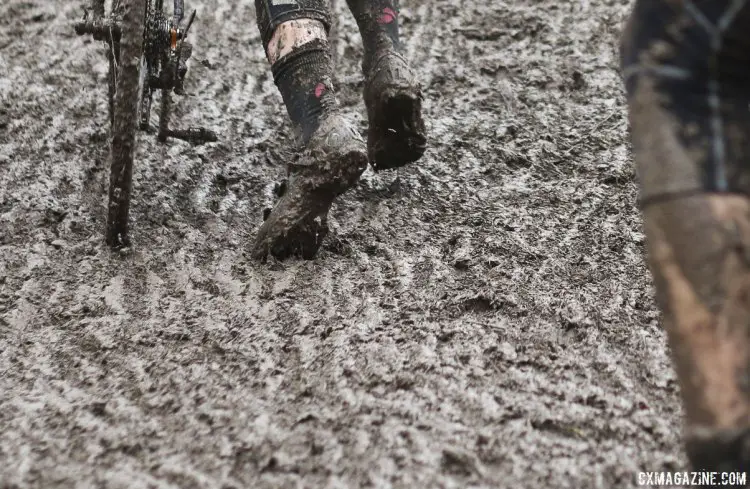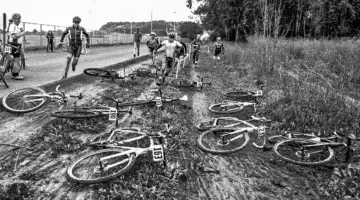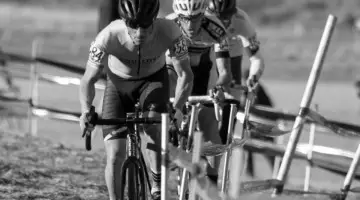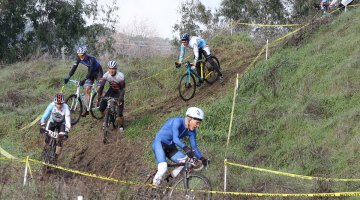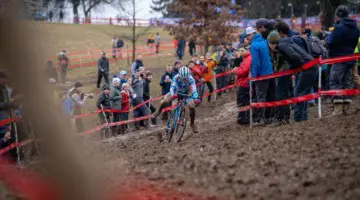Last week, Adam Myerson demystified interval training and looked at which blocks were ideal for cyclocross athletes. But if cyclocross was only about the work that’s put into a trainer, we would never get to enjoy getting our bikes dirty. This week, Myerson looks at the challenge of mud during cyclocross, and the approach riders should have when approaching the mud pits before and during a race.
Most of this advice will be for folks who have time to do more than warm bottles and change diapers. For those who haven’t heard, Flynn Austin Checchio Myerson is the newest member of the cyclocross community. Congratulations, Adam, on your beautiful son!
You can find other training ideas and articles at cycle-smart.com, as well as information on internationally-recognized coaching and clinic programs for all skill levels.
by Adam Myerson
As cyclocross has grown and developed in the US, we’ve typically drawn our inspiration from images and stories of European events. And on a continent where there’s lots of farmland, lots of rain, and temperatures that rarely go below freezing all fall and winter, that means mud is often a main feature of European races, especially in Belgium, the Netherlands, and Switzerland, where the sport is most popular.
The thing is, you don’t need mud for a cyclocross race. Mud is not endemic to the sport, and not necessary for an interesting or enjoyable race. French races are a great example of this, where grassy, fast courses resemble what you might find in New England, and remind us that just like there is no single style of course in the US, there is actually no such thing as “European ’cross,” either. Some US organizers have missed that point in the past, and taken to flooding their courses to ensure a spectacle, instead of letting the racing be the spectacle itself. It’s your weather and geography that should determine the conditions you race in, not man-made modifications to the land provided by a garden hose.
That said, there’s still something special about racing in the mud, no matter where you live or how often you get to do it. A rainy or snowy day that deteriorates into a mud-bath provides for one of those epic races that will be talked about for seasons to come. When you don’t race in the mud every weekend, a muddy race can catch you by surprise. It requires a different type of effort, technique, mindset, and rhythm from a dry, fast race, and it can be difficult to get into that groove when then November rains come. Here are some things to focus on when riding in the mud.
Tire Choice
Almost every tire manufacturer had a mud tire these days, whereas in the past riders simply rode the same chevron-style tread and simply adjusted their riding style for slippery conditions. A good mud tire should have aggressive knobs, spaced far enough apart so that they don’t pack and clog with mud, and which extend far down the side of the tire for good cornering traction. Additionally, you want to be able to ride that tire at the lowest pressure possible without bottoming out or flatting, to provide the maximum contact patch and flexibility with the ground. Depending on your body weight, riding skill, and tire/rim type, that can be below 20 psi. Experiment in training and find that limit for yourself.
Cornering
Any kind of cornering should be broken down into two extremes: slow speed turning, where you literally turn the bars noticeably to corner, and high speed leaning, where you get on the sides of your tires and turn the bars slightly and imperceptibly. The less traction you have, the slower you will likely be going, and the more you will rely on turning rather than leaning to make a corner. This means keeping the bike more upright as you turn, staying on the tread of the tire, and relying on the sidewall less. However, a muddy off-camber or U-turn will still put you on the sides of your tires, and this is where being comfortable with sliding or drifting, and possibly riding with the inside foot out to act as a stabilizing tripod leg, can be helpful. In almost all cases, staying seated to keep the weight back and balanced between the tires is helpful, but also, shifting some of that weight to the balls of both feet without actually standing up out of the saddle will let the wheels stay in contact with the ground and maintain traction, rather than bucking you off at every small bump.
Speed Changes
When you have to slow down so dramatically for every corner and transition, it can be easy to continue to ride in that steady state style and miss opportunities to make up time between turns. It’s important to maximize every opportunity you have to make watts while you have the chance. That means putting 100% effort into accelerating as quickly as possible after every corner or dismount. In a muddy race, getting from point A to point B is even more important, beacuse there are often fewer windows to do so. It may be physically challenging, but it’s also mindset shift. Of course, some muddy races are simply a watt/kilogram contest without much technique, and on those days there isn’t much you can do other than pedal hard from start to finish.
Line Choice
At our ’cross camp, I teach a technique I refer to as “largo,” which means “wide” in Italian. On my first trip to Europe in 1996, I was taking terrible lines at the GP Mamma e Papà Guerciotti in Milan, as I was still learning how to deal with the extreme mud. Spectators kept yelling “LARGO! LARGO!” at me and literally pointing to the wide line on the outside of the tape, as I kept trying to go the short way around the turns and sliding out. It was a revelation, and changed my entire riding style from that day forward. The short way is almost never the fast way when traction is limited. It’s almost always better to go the long way, make a more gradual turn, and maintain traction, power application, and speed. Additionally, even on straight sections of mud, you have to be willing to ride the edges, and switch sides from tape to tape to find fast ground. “Green is grip” is a phrase I’m fond of using.
Cadence
One mistake I see riders make in the mud is to try to spin a small gear when they’re bogged down in the deep stuff. This causes their weight to shift quickly with each pedal stroke, affecting their balance by changing the direction of energy sharply and frequently, and causing their rear wheel to spin rather than dig in. A big gear and more pedaling torque will allow the rear wheel to bite deeper and give more traction. There is certainly balance between riding a low cadence and ultimately being bogged down, and experience will help you find that spot.
Weight Distribution
’Cross technique isn’t just about barriers, but also about how you can make power across uneven and inconsistent terrain. One aspect of this allowing your bike to float in a different direction than your body, as you keep your body centered and moving forward to maintain momentum. You’ll often see photos of riders with their wheels perfectly lined up in a rut, with their arms extended and their upper body off to one side. Riding in the mud is often a bit of tightrope walking, where your body acts as the stabilizing pole while your bike stays on the line.
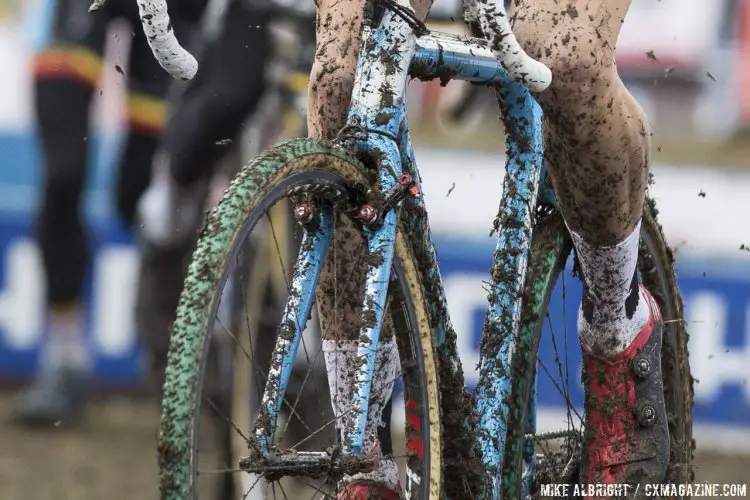
Wout van Aert raced Niels Albert’s old Michelin Mud-treaded Dugast tubulars at the 2015 Cyclocross World Championships. © Mike Albright / Cyclocross Magazine
Also, maintaining traction while pedaling requires staying in the seated position (sometimes fully seated, sometimes slightly unweighted). Too often I see riders trying to accelerate in the soup by getting out of the saddle, only to have their rear tire spin underneath them. There are no shortcuts when riding in the mud, and it’s best to stay seated and pedal with your weight over the rear wheel, only standing to accelerate once you’re on firm ground.
Running
Often riders will try to stay on the bike at all costs, resulting in lost time. When in doubt in a muddy race, always opt to dismount and run before you lose momentum and tip over, or make a mistake. Maintaining momentum is a core component of ’cross, and this is where dismounting skills matter as much as they do for barriers. If you attempt to ride a deep section of mud that you’re not sure you can clear, be ready to abandon the ship at first loss of speed, rather then forcing it until it’s too late. Similarly, if you’re unsure if you can ride a turn as the line deteriorates over the course of the race, dismounting just for the corner and remounting on the other side is fast, consistent, and reliable. Plan ahead, and always be ready to hit the eject button.
Training
On those days where you have a workout planned but the weather is terrible, rather than staying indoors and riding the trainer, take the opportunity to do a workout in the mud or slippery grass. Outside of racing, most riders never experience racing in bad conditions, but those miserable days during the week are something you want to take advantage of. It requires some mental energy and a little extra clean up time, but you’ll likely have a great time once you’re out there, and you’ll be that much more prepared for the mud in the next race where you’re confronted by it.
These tips will make a difference if you put them to use next time the grass turns to mud. Years of experience and lots of power helps, too, but that doesn’t mean you can’t make the most out of what you’ve got. In general, make sure you pick the right tires, keep power to the pedals wherever possible, and are thoughtful and creative with your line choices, and you can turn a weakness into a strength.













